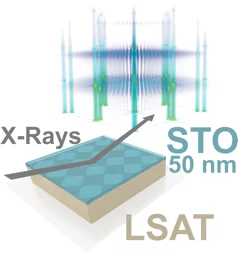The authors find that an annealing process can create a highly ordered network of two-dimensional line defects at the buried interface between a relaxed film and its substrate. The low dimensional network spacing is directly related to the lattice mismatch and can correspondingly be tuned by the choice of substrate.
We identified a highly ordered moiré lattice at the buried SrTiO3 (STO)-(La,Sr)(Al,Ta)-oxide (LSAT) interface by high-resolution x-ray diffraction reciprocal space mapping. We found long-ranged ordered supercells of 106/107 unit cells of unstrained STO-LSAT caused by complete lattice relaxation through high-temperature annealing. Transmission electron microscopy images show that this periodicity is based on line dislocations at the interface region. The presence of such ordered superstructures in such widely used complex oxides sets the ideal conditions for moiré-tuned interfacial electronic modifications and ferroelectric supercrystallinity, opening the possibility for interface functionalities and impacting findings on vortex structured multilayers systems.
Contact
Dr Urs Staub
Microscopy and Magnetism Group
Paul Scherrer Institute, Forschungsstrasse 111, 5232 Villigen PSI, Switzerland
Telephone: +41 56 310 44 94
E-mail: urs.staub@psi.ch
Original Publication
Buried moiré supercells through SrTiO3 nanolayer relaxation
Max Burian, Bill Francesco Pedrini, Nazaret Ortiz Hernandez, Hiroki Ueda, C. A. F. Vaz, Marco Caputo, Milan Radovic, and Urs Staub
Phys. Rev. Research 3, 013225 – Published 9 March 2021
DOI: 10.1103/PhysRevResearch.3.013225

